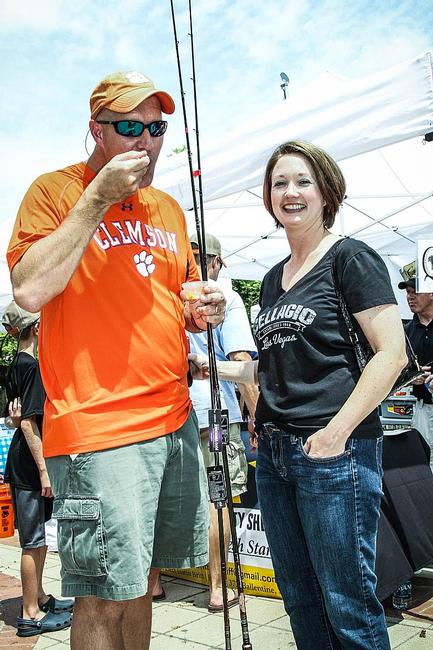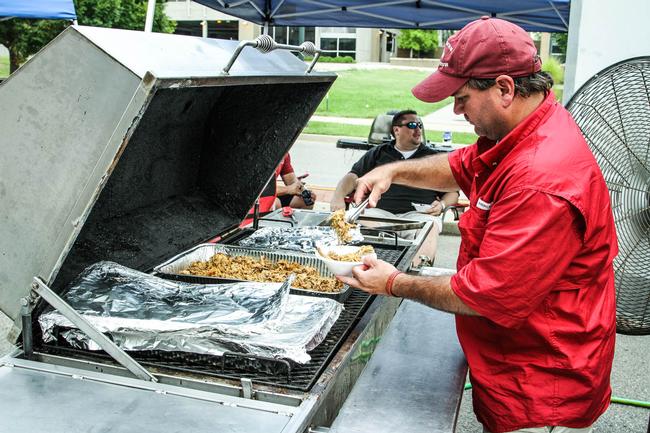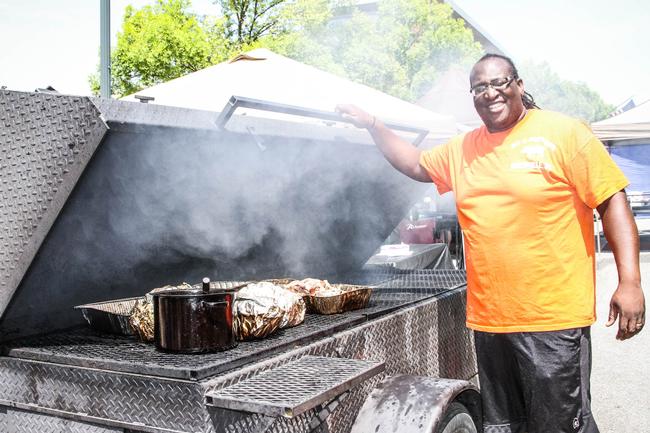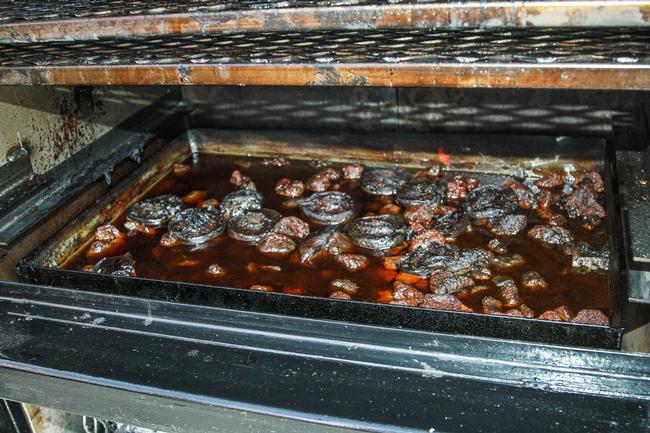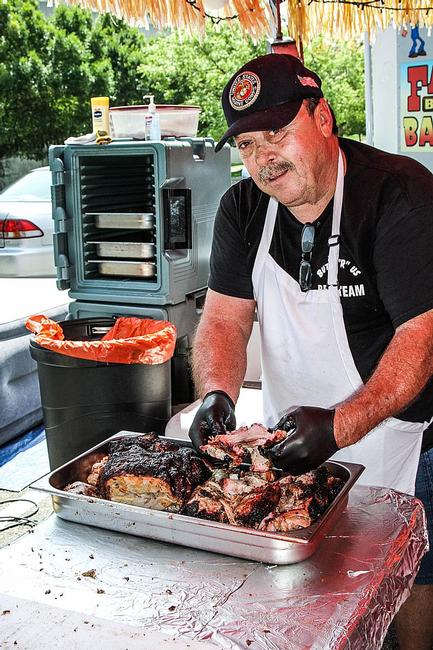Low and Slow on BBQ Row

Preparation, a solid game plan, perfect execution – sounds like the ingredients to a Forrest Wood Cup victory. But those elements are also required of the best competitive barbecue cooks, like the members of the South Carolina Barbecue Association (SCBA) who turned out for the first-ever Bass & BBQ festival, held in conjunction with the FLW Expo in Columbia, S.C., during the Forrest Wood Cup.
I just so happen to be a huge fan of slow-cooked pork butt … and chicken, ribs, beef brisket and just about any other meat cooked low and slow over smoldering wood. Needless to say, I was amped about my assignment to sample the fares while on site to cover the Cup.
In fairness, scheduling and editorial space prevent a comprehensive analysis of the many diverse styles of hardware and tactics. So, let’s just say that pitmasters all have their preference for smoker, seasoning and presentation, while each showed the requisite dedication with lounge chairs, air mattresses, portable TVs and other creature comforts necessary for the long, long – did we clarify, looooooong – process of turning the lowly swine into an elevated culinary experience.
Barbecue teams primarily focused on traditional pork butts and competed for awards presented at the Colonial Life Arena prior to Sunday’s final weigh-ins, but the public got first crack at their wares. On Saturday, $5 bought five tickets, each traded for a 2-ounce sample from the vendor of choice. Sunday saw pitmasters offering full-sized portions for sale.
Yes, I tried several. Yes, I had a favorite. No, I will not reveal my preference.
The judges did proclaim a winner, however. Here’s the rundown of the top five:
1. Up in Smoke – Brian Teigue – $3,000
2. Big Dick’s BBQ – Richard Moore – $2,000
3. Smokin Stacks – Jeff Smith – $1,500
4. Buckwheats BBQ – Dewayne Jones – $1,000
5. Blind Swine BBQ – Mike Sanders – $500
Perfect Pork
I was but a simple scribe blessed with the opportunity to query these sultans of smoke and coal on points to improve my amateur efforts. Tips on principles, preparation and proper seasoning can help even a budding barbecue fan like me wow the home crowd. And after a couple of hours on barbecue row, I walked away with much more than a full stomach and the pleasant linger of hickory smoke on my clothing.
My first tip came from Lake High, a master judge and president of the SCBA – a governing body of sorts for public events and competitive judging. Low-and-slow is the universal standard for barbecue preparation, but as High points out, the Palmetto State boasts four distinct regional barbecue styles: mustard-based, vinegar, light ketchup and heavy ketchup.
“In South Carolina, an event like this does double duty,” High says. “Everybody loves barbecue, and if you have one of these events in Georgia, everyone comes and has a good time, and it will raise the awareness of barbecue in that area. But in South Carolina, we’re the only state in the nation with four kinds of barbecue, so this event serves to raise the awareness of the different styles for people to enjoy.”
Championing the South Carolina barbecue message on a national scale, pitmaster Cheyenne Ledyard of Ledyard BBQ Company in Summerville, S.C., recently competed on the History Channel’s American Grilled. Specializing in pork butts and spareribs, Ledyard says that barbecue is a very personal craft that ultimately rewards diligence.
“The preparation is very important because what you put into the smoker is what you get out,” he says. “I have a company called The BBQ Pantry that specializes in fresh, hand-ground spices, and I think that sets my barbecue out from those who use store-bought spices.”
As Ledyard points out, South Carolina is widely considered the birthplace of barbecue, and that traces back to the introduction of feral pigs by Spanish Explorers. Noting the Native American technique of cooking meats over open spits prompted Spaniards to experiment with pork. Centuries of trial refined processes and inspired various smoker and slow-cooker designs.
Ledyard, whose accolades include a first-place finish at the Rib Throwdown on July 4 in Mullins, S.C., also produces a line of barbecue sauces. Some folks prefer only dry rubs, while some won’t eat barbecue without sauce. Ledyard says that whether you’re cooking for judges or just a family dinner, let your personal tastes guide your decisions.
His formula for success: dry rub, lots of smoke, a little bit of sauce – not over-sauced – and let the meat stand on its own.
“The best barbecue is the barbecue that you like,” he adds. “If you like it with no sauce, then you should eat it with no sauce. If you like it with tomato sauce, you should eat it with tomato sauce. Same for mustard sauce or vinegar – that’s how you should eat it.”
Take-Home Tips
Here are a few more interesting tips from Bass & BBQ pitmasters:
John O. Brown Jr., Southern Que-N-Stew: Pork butts need fat for flavor and tenderness, but trimming the excess exposes more of the meat and allows it to absorb more of the dry-rub seasoning. Doing so creates that flavorful, dark out layer known as the “bark.”
Rubs are a personal deal, and everyone has his favorite blend, but Brown says go easy on the salt. Too much of this harsh spice will overwhelm the natural meat flavor.
Cheyenne Ledyard, Ledyard BBQ Company: Stout, pungent hickory wood works well with larger cuts like brisket and pork butts, while the lighter, sweeter cherry wood is his choice for ribs and chicken.
Joe Wilson, Mo and Joe’s BBQ: Keep your meat moist with occasional shots of seasoned water. Wilson fills a plastic squirt bottle with water, lemon wheels and a secret blend of spices to create what he calls “Junk Juice.”
Jason Hardee, Elite BBQ Smokers: Water pans between the heat source and the meat are essential for maintaining meat moisture, but Hardee adds peach halves to his tray. The naturally sweetened vapor enhances meat flavoring. He’ll also add Vidalia onions to his coals to bolster the smoke flavor.
Butch Kelly, Butts-R-Us: Preparation styles vary from chopped to minced, but whether he’s presenting his turn-in box to judges or serving the public, Kelly prefers a traditional pulled pork look that you can’t get with forks and cleavers. Donning a pair of latex gloves, he gets up-close-and-personal with the meat he’s labored long to prepare – the only way to “feel” the proper texture and consistency.
Making it Official Food
Here’s a cool tidbit to end on: During Wednesday night’s red carpet event for Forrest Wood Cup competitors and their families, South Carolina Senator Katrina Shealy declared barbecue her state’s official picnic food in a televised press conference.
That’s impressive, but I’m not waiting for any picnic.
Yo, pitmaster, hook me up with a pulled pork sandwich, easy on the sauce.
